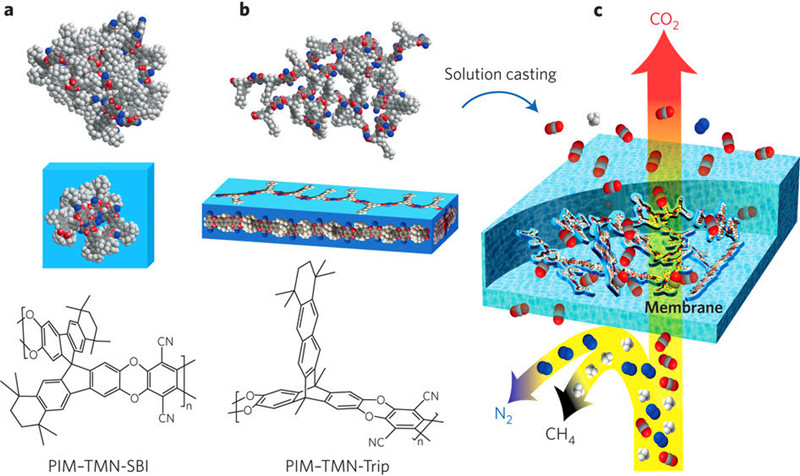A News and Views article by Professors Yan Yin and Michael D. Guiver of School of Mechanical Engineering, Tianjin University, has appeared in the July issue of Nature Materials. It covers a breakthrough for both ultrahigh permeability and good selectivity for gas separations using microporous membranes.
Industrial membrane gas separation began in the 1980s. Compared with established molecular-separation processes, the membrane technology achieves higher efficiency at lower cost and is widely applied to gas separation. The dominant separations are currently N2 production from air, CO2 removal from natural gas, and H2 recovery from various industrial process streams. The role of membranes has been increasingly expanded to other important separations.
In the membrane field, poly (trimethylsilyl-1-propyne) (PTMSP) has long been established as an ultrapermeable microporous polymer, with the highest known gas permeability. The goal for membrane separations is to improve the balance between productivity (permeability) and separation efficiency (selectivity). Higher flux and selectivity, and lower driving force can achieve cost reductions and simplification of systems. However, higher gas permeability often comes with lower selectivity.
In the News and Views article, Professors Yan Yin and Michael D. Guiver provide analysis, perspectives and opinions on a landmark paper “Polymer ultrapermeability from the inefficient packing of 2D chains” by Ian Rose and colleagues, also published in Nature Materials. Professors Yan Yin and Michael Guiver summarize and point out important details about the Ian Rose et al. paper on membrane derived from a ‘polymer of intrinsic microporosity (PIM). The polymer membrane is the first with both ultrapermeability and superior selectivity, thus launching a new chapter in the design of PIMs for high-performance membranes for gas separation. PIM materials design is also one of the main research areas of Professor Michael Guiver’s Tianjin University group, who is considered an expert in this area to provide opinions for Nature Materials.

The incorporation of rigid bridged bicyclic triptycene (Trip) into PIM chains resulted in further improvements in gas selectivity. PIM-TMN-Trip behaves like a typical PIM, but is much more permeable. Therefore, for the first time, a PIM competed with ultrapermeable PTMSP, but had a clear edge, as it is chemically and physically more robust, more selective, ages less rapidly, and withstands heating without porosity collapsing.
Also, Professors Yin and Guiver pointed out that there were challenges to realizing industrial-scale PIM membranes, such as multistep syntheses, mechanical properties, feed impurity and mixed gas streams resistance, whether current selectivities would be sufficient in the ultrapermeability range, and concerns about long-term stability and physical ageing. This may be offset by the knowledge that thin films, as encountered in selective layers coated onto hollow fiber supports, age rapidly. In doing so, gas selectivity increases further at the cost of permeability, but overall performance will be maintained, well above the upper bounds. Therefore, Professors Yin and Guiver anticipated that “the novel molecular design approach to ultrapermeable membranes reported by Rose et al. will set new directions for further improvements and stimulate the competitiveness of membrane technology where massive feed volumes are encountered, such as the separation of carbon dioxide from flue gas”.
Source article: Microporous polymers: Ultrapermeable membranes (http://www.nature.com/nmat/journal/v16/n9/full/nmat4961.html?foxtrotcallback=true) (Published online on July 31, 2017 in Nature Materials 16, 880–881 (2017) doi:10.1038/nmat4961.)
Image by: Yan Yin and Michael D. Guiver
Article by: Sun Xiaofang
Editors: Yin Shiyu, Yan Yin, Michael Guiver, and Ross Colquhoun






